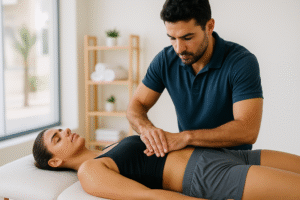
Myofascial Release Guide: Relieve Pain & Restore Mobility
Discover doctor-led myofascial release that targets fascia, eases chronic pain, and boosts flexibility. Personalized manual therapy restores natural movement.
Observing a persistent head tilt or difficulty in turning the neck, whether in a newborn baby or an adult, can be a source of significant concern. This condition, known as torticollis or "wry neck," stems from tightness in the neck muscles, leading to a tilted and rotated head posture. While it can be distressing to witness, it's important to know that torticollis is highly treatable. For parents of newborns and adults seeking relief, understanding the role of specialized care is the first step towards recovery. Effective, doctor-led torticollis physiotherapy can make a profound difference, offering a gentle yet powerful path to restoring normal movement, comfort, and alignment.
Torticollis presents primarily as a postural issue, but its origins and implications can vary. The most common form is Congenital Muscular Torticollis (CMT), which appears in infancy. It's often caused by an infant's positioning in the womb or a difficult birthing process, leading to the shortening or tightening of the sternocleidomastoid (SCM) muscle, the large muscle that runs down the side of the neck. When this muscle is tight, it pulls the head into a tilt toward the affected side and a rotation toward the opposite side.
In adults, torticollis can be acquired due to various factors, including muscle strain from sleeping in an awkward position, injury, or even as a symptom of an underlying neurological condition. Regardless of the cause, addressing it promptly is crucial. In infants, untreated torticollis can contribute to the development of plagiocephaly (flat head syndrome) and may delay motor milestones like rolling over and sitting up symmetrically. For adults, it can lead to chronic pain, muscle imbalances, and persistent headaches. Seeking a proper diagnosis is the essential first step to developing an effective treatment plan.
When it comes to treating a condition as nuanced as torticollis, the expertise of the practitioner is paramount. A surface-level approach that only addresses the symptoms—the head tilt—will not yield lasting results. This is why a doctor-led approach, a core principle at Physio Cure Dubai, is so vital. This means that your entire treatment journey, from the initial evaluation to the final discharge, is managed by a licensed physiotherapist holding a Doctor of Physical Therapy degree, not a technician.
The process begins with a comprehensive assessment aimed at a "Root-Cause Diagnosis." The therapist will carefully examine the neck's range of motion, muscle tone, and strength. For infants, the assessment also includes checking for associated conditions like hip dysplasia and evaluating overall motor development. For adults, the physiotherapist will investigate potential underlying causes related to posture, ergonomics, or previous injuries. This deep diagnostic dive allows for 100% personalized care, where the treatment plan is tailored to the individual's specific needs, lifestyle, and recovery goals. Our team of specialists includes practitioners like Dr. Talaat Abdelhakeem, renowned for his compassionate and highly effective approach to pediatric physiotherapy, ensuring even the youngest patients receive the highest standard of care.
Key Tip: Early intervention is critical for infants. Addressing torticollis within the first few months of life significantly increases the likelihood of a full recovery without the need for more invasive procedures.
The treatment for infant torticollis is a multi-faceted program centered around gentle, consistent, and playful interventions. A physiotherapist guides parents through a series of techniques designed to lengthen the tight SCM muscle and strengthen the weaker, opposing one.
These are the cornerstone of treatment. A physiotherapist will teach parents how to perform specific passive stretches safely. These are slow, deliberate movements designed to gently elongate the tight neck muscle. Common stretches include the "ear-to-shoulder" stretch (gently tilting the head to bring the ear towards the shoulder on the unaffected side) and the "chin-to-shoulder" rotation stretch. The key is to perform these movements without causing pain, holding each stretch for about 30 seconds and repeating them several times throughout the day, often during routine activities like diaper changes.
Supervised tummy time is not just for preventing a flat head; it's a critical exercise for treating torticollis. When on their tummy, an infant must work against gravity to lift and turn their head, which naturally strengthens the neck, shoulder, and upper back muscles. A physiotherapist can suggest ways to make tummy time more effective and engaging, such as using rolled-up towels for support or placing fascinating toys in a way that encourages the baby to turn their head towards their non-preferred side.
Simple changes in the baby's environment can provide a constant, gentle "stretch" throughout the day. This involves positioning stimulating objects, such as toys, mobiles, lights, and even the parents themselves, on the side the baby needs to turn towards. This encourages active turning and stretching. Other tips include alternating the arm you use to hold the baby and changing their position in the crib so they must turn their head to see out into the room.
While in-clinic sessions are vital for assessment and hands-on therapy, the real progress happens at home. The success of `torticollis home exercises` relies heavily on caregiver consistency and confidence. This is why patient and family education is a fundamental stage of the recovery journey at Physio Cure. Your physiotherapist acts as your coach, empowering you with the knowledge and skills to carry out the treatment plan effectively. These strategies are supported by extensive research, including recent studies on the effectiveness of early physical therapy intervention highlighted by PubMed, which underscores the importance of a structured program.
Here are some guiding principles for your home program:
A holistic, evidence-based approach combines skilled hands-on therapy with a deep understanding of the patient's overall well-being. It’s about treating the person, not just the symptom, to achieve lasting results.
For adults with torticollis, the home program may include specific self-stretching techniques, postural correction exercises, and ergonomic advice for their workspace and sleeping setup. The goal remains the same: to restore balance and function through active patient participation.
While stretching and strengthening are the primary tools, a comprehensive treatment plan may also integrate advanced therapeutic modalities to accelerate healing. Manual, or hands-on, therapy is the cornerstone of treatment at Physio Cure, where skilled therapists use precise techniques to mobilize soft tissues and joints, releasing tension and improving movement.
For more complex or persistent cases, particularly in adults, other modern modalities may be used. Techniques like Dry Needling can be employed to release stubborn trigger points within the tight muscle, while Cupping Therapy can help improve blood flow and reduce muscle tension. This integration of traditional hands-on skill with evidence-based modern technology ensures that every patient receives the most effective care for their specific condition.
Ultimately, successful torticollis physiotherapy is about more than just correcting a head tilt. It's a journey of restoring balance, preventing secondary complications, and empowering individuals and families with the tools for long-term health. It requires a compassionate, expert-led approach that sees the whole picture and tailors every step to the unique needs of the patient, guiding them from diagnosis back to a full, active life.
If you are concerned about torticollis, don't wait. A professional assessment is the first step towards peace of mind and effective treatment. Contact Physio Cure Dubai today to schedule a consultation and begin the journey to recovery.

Discover doctor-led myofascial release that targets fascia, eases chronic pain, and boosts flexibility. Personalized manual therapy restores natural movement.
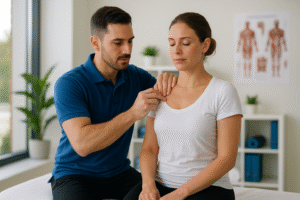
Learn how doctor-led trigger point therapy at Dubai’s leading clinic conquers chronic muscle knots, boosts mobility, and delivers lasting, root-cause pain relief.
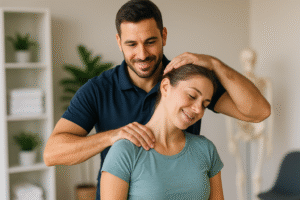
Discover how joint manipulation targets pain at its source, boosts mobility, and speeds recovery. Explore doctor-led physiotherapy for lasting relief.
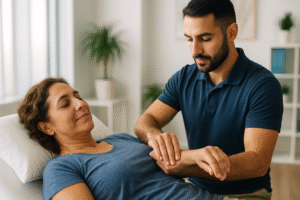
Discover doctor-led soft tissue mobilization that targets pain, breaks scar tissue, and restores full movement. Book evidence-based physiotherapy in Dubai.
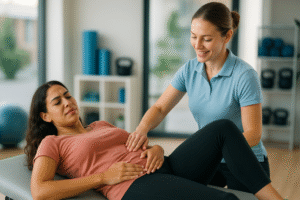
Endometriosis pain doesn’t have to rule your life. Physiotherapy targets root causes, releases pelvic tension, and restores comfort. Book a consult today.

Discover doctor-led physiotherapy for pregnancy lower back pain relief. Gain root diagnosis, customized exercises, and guidance for a pain-free journey.
Physio Cure Dubai, located in Dubai Silicon Oasis, offers a comprehensive range of physical therapy services. Our team of the best physiotherapists in Dubai are all real doctors providing personalized care, using the latest technologies and evidence-based techniques to help you, your child, and your loved ones recover and live a pain-free life.
DHA License No. 5411940
1510, SIT Tower, Dubai Silicon Oasis